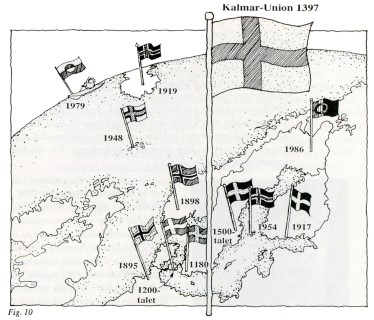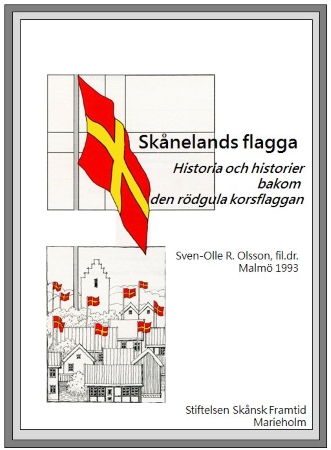
THE FLAG OF SCANIA
The complete text
"The Red and Yellow Cross Flag, History and Stories Told"
Sven-Olle R Olsson, Ph.D. Malmö
Publisher and Copyright: Stiftelsen Skånsk Framtid. 1993.
Due to the size of this publication, it has been divided into three parts:
Part 1: Foreword - Historical beginnings.
Part 2: History of the modern Scanian Flag.
Part 3: Appendices.
Foreword
Much confusion surrounds the red and yellow cross flag, which is often called "den skånska". However, it is a regional and cultural flag - national flag if you want - for Scania as a whole - Skåne, Halland, Blekinge and the Island of Bornholm.. In order to clarify the concepts and organise the material about its history, the Stiftelsen Skånsk Framtid has asked Sven Olle R. Olsson, Ph.D., of Malmö to research the matter. The results obtained so far are presented in this essay which includes both history and stories about the flag.
We at The Foundation feel it is important to emphasise that Scania's flag has been officially registered in the Scandinavian Register of Coat of Arms (SVR 431/92 B:15) and is completely free of any associations to political parties or organisations.
It is a neutral, cultural symbol for Scania, with roots far into the past. The Stiftelsen Skånsk Framtid encourages everybody to use it.
Stiftelsen Skånsk Framtid (Copyright)
PART I
Historical beginnings
The flag of Scania, in everyday speech often called "den skånska", is represented as being that of the whole of Scania, i.e. the common unifying symbol for Skåne, Halland, Blekinge and Bornholm, but its use in earlier times is hidden in the shadows of the past.
Just as is the case with the common history of Scania, interest in researching the background of the Scanian flag has been limited. We therefore still lack definite evidence of events that various individuals have associated with the red and yellow cross flag.
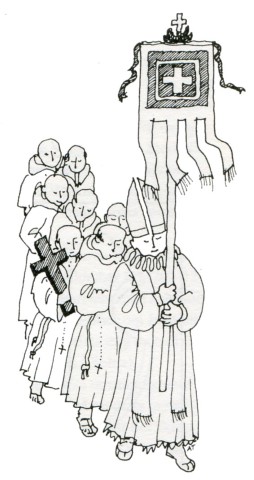
The Archbishop of Lund
However, the flag has been associated with the Archbishop of Lund, who is said to have carried its colours as a banner as early as the 12th and 13th century.
The Nordic area broke off from the archdiocese of Hamburg-Bremen in 1104 in order to establish a unit of its own. The primate of this unit was the Archbishop of Lund who in this way became the Scanian Nordic Archbishop, the first of whom was Ascer (1089-1137). It is likely that the Archbishop of Lund had some kind of standard. If the Archbishop of Lund had such a banner, it was probably given by the Pope. Since the Archbishop of Hamburg-Bremen carried the colours of a white cross on a red background, the new independent Nordic archdiocese is not likely to have carried the same colours. Therefore, it is more probable that the Archbishop of Lund carried different colours, e.g. a yellow cross on a red background instead of a white cross on a red background.
The cross coat of arms
As in the Nordic cross flags, the cross coat of arms naturally traces its origin to the cross banners that were carried by the medieval Christian princes during the crusades. The banner was the personal sign of authority of the ruler. Both the German emperor and the French king carried a red coat of arms with a silver cross. This coat of arms lives on in the Danish Dannebrog flag and in Switzerland's flag.
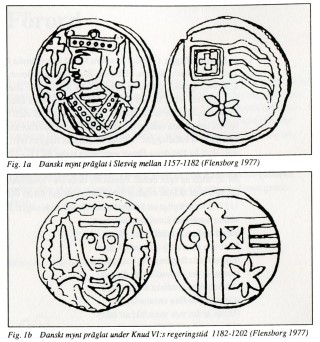
The cross coat of arms was not prominent among the Old Catholic archbishops in Lund. Instead, their symbol was the Laurentian gridiron, which to this day is the coat of arms of the Diocese of Lund (Fig. 5). This in itself is not so strange, since the Cathedral of Lund is dedicated to St. Lars. However, a coin has been found that was minted in Schleswig some time between 1154 and 1182 during the reign of King Valdemar the Great (Fig. 1a). On its reverse side is depicted a so-called gonfalon with a cross coat of arms similar to the flag of Switzerland and equipped with four streamers. This type of flag is also found in the coat of arms of the District of Frosta (Fig. 2).
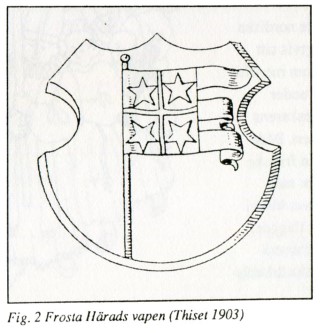
A similar flag from the days of the reign of Canute VI is found on the reverse side of the coin in Figure 1B, but here the cross is twisted into an x-shape. Similar flags occur primarily as banners and several of these are onsidered to have been given by the Pope. One example of this is the gonfalon (Fig. 3) from the Tapestry of Bayeaux, depicting the conquest of England by William the Conqueror at Hastings in 1066. The tapestry - it is thought - was made a decade or so later.
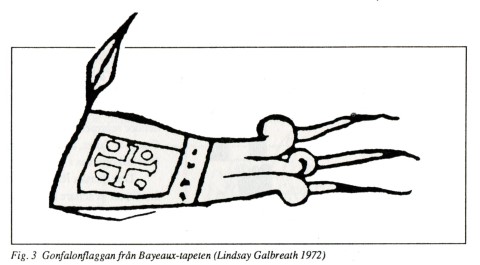
The Colours of the Flag
This gonfalon (Fig. 3) with the colours white and gold (yellow cross on a white background) was given to William by Pope Alexander II, 1061-1073 (Lindsay Galbreath, 1972). This makes it likely that the same also applies to the gonfalon of Valdemar the Great. The colours, tinctures or metal, in the latter case, are still not known to us, but it appears likely that the cross coat of arms on the gonfalon was red with a white cross, since Valdemar the Great (1157- 1182) has placed himself under the Order of St. John. Its flag, red with a white cross, was recognized by Pope Innocent II in the year 1130. Valdemar the Great also founded, together with Archbishop Absalon (1177-1201) the Monastery of Andvorskov, which became the centre of the Knights of St. John in Denmark.
His successors, Canute VI (1182-1202) and Valdemar II (1202-1241) continued this cooperation with the Knights of St. John. (This information was communicated to me by Bertil Persson, Professor of Theology, of Solna.).
In any case, we can be certain that this coin discovery (Fig. 1a) represents the oldest, Danish flag known. This in turn means that a Danish cross flag was carried as early as at the end of the 12th century. Generally, with respect to Danish coins from this time, it is probable that the reverse sides of the coins represent the Archbishop and the Church, while the obverse sides represent the power of the King. If this is the case, this gonfalon is the banner of the Archbishops of Lund.
The Danish red and white flag can be found later in the coat of arms of Valdemar Atterdag (Fig. 4).
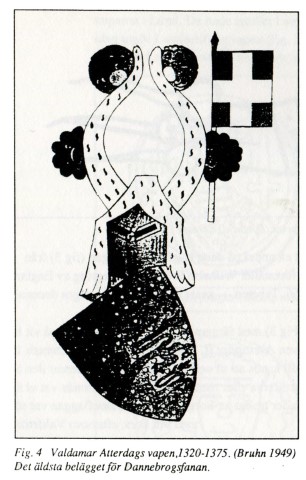
According to legend, the Danes received the Dannebrog in the Battle of Volmer at Reval in 1219, during Valdemar Sejr's crusade to Estonia, and it is said that the Knights of St. John carried their coat of arms, the white cross on a red background, during this crusade. As far as the Scanians are concerned, however, it is said that they were actually under the jurisdiction of Andreas Sunesen at the Cathedral of Lund. As opposed to this, the historian Carl-Gustav Liljenberg has pointed out in a letter that Waldemar simply stole the red and white flag of the Low German, Saxon, Gotlandic and Livonian crusaders, which was that of the Archdiocese of Hamburg-Bremen.
This legend could then have been copied by the Swedes, since they wanted to be as good as the Danes. According to the Swedish legend, Eric the Holy received the yellow cross from the blue skies in Finland during his crusade in 1157. Alf Åberg has also put forward the theory that the Swedish flag arose as a resistance flag against the Danish Union in the mid 1400's, and that it was the rebellious Karl Knutsson Bonde who was behind it. Another theory, proposed by Carl-Gustav Liljenberg, is that Erik XIV of Sweden adopted the blue and yellow cross coat of arms of the city of Riga in 1562, in order to incorporate Riga's important trade system with the Swedish. The first pictures of a blue cloth with a yellow cross as a Swedish flag is a provincial coat of arms for southern Finland on the 1550's and one for Gotland during the funeral cortege of Gustav Vasa in 1562, declared Clara Nevéus, the State Heraldist, in a letter.
The Archdiocese of Riga's yellow coat of arms on a red background derives its origin from Albert de Buxhoevden (Bishop of Riga from 1199-1229), who founded both the diocese in 1201 and the Order of the Sword in 1202. Pope Innocent II recognised both the Order and its coat of arms, a yellow cross on a red background, in 1202. This Albert cooperated with the Archbishop of Lund, Andreas Sunesen (1201-1228), who undertook the crusade to Estonia in 1206. Later, Albert asked Valdemar II/Sejr for his assistance in continuing the Christianisation of Estonia, and the result was the battle at Lindanisa, later Reval, now Tallinn on June 15, 1219. The Christianisation of Estonia was thereby almost complete. Estonia came under the jurisdiction of the Archdiocese of Lund (1219-1346). Andreas Sunesen, who accompanied Valdemar Sejr in 1219, remained in Estonia until 1221. Through the central role played by Albert de Buxhoevden, this red and yellow flag became the coat of arms of the Diocese of Riga, and Andreas Sunesen adopted this coat of arms as his own and that of the Archdiocese of Lund. (This information was conveyed to me by Bertil Persson, Professor of Theology, Solna.)
Thus, there is some evidence that Scania's flag has its origin in the Diocese of Riga and that Andreas Sunesen was the first bearer of this cross coat of arms. It is also probable that the Dannebrog derives its origin from the coat of arms of the Knights of St. John from the 1160's, and that it is this coat of arms this is shown on the gonfalon on the coin.
Uppsalaflaggan
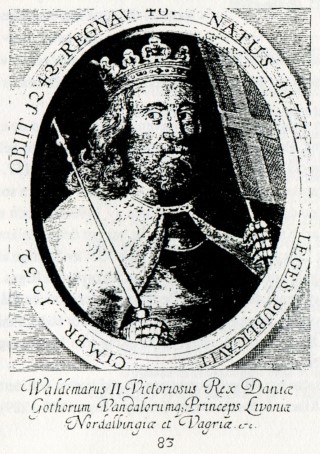
The Archbishop of Uppsala, Nils Allesson, carried from 1296 a cross coat of arms, whose colours we do not know. Not until the mid 1400's do the colours of a yellow cross on a red background appear on the shield of the Archbishop Jöns Bengtsson (Oxenstierna) in the Church of Rasbo from 1456. This coat of arms was then maintained as the coat of arms of the Archdiocese of Uppsala and later its flag. The coat of arms and flag of the Swedish Church are the inverted colours and equipped with a golden crown in the centre of the cross, which in turn is based on a coat of arms from the 14th century in the Cathedral of Uppsala (Fig. 5). Thus, it is quite possible that Nils Allesson received his coat of arms from his primate in Lund in the same manner as the diocese of Åbo received its inverted cross coat of arms from the Archdiocese of Uppsala.
The Nordic Flag
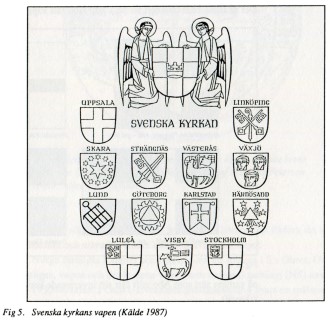
A secular Nordic flag symbol was created in the 15th century by the Union King, Erik of Pomerania. In 1430, he wrote that: "rykens baner Swa som aer eth röth kors oppa eth gulth fiaeld" and this means that this cross coat of arms was or should be the common coat of arms of the kingdoms or the kingdom. So here we have the oldest Nordic Union flag, and in more recent times it has been introduced as such by the Nordic Association (Fig. 6). Could Erik of Pomerania have got the idea for this design from the coat of arms of the Archbishops of Lund? It appears likely that he used the symbol of the archbishops for the Nordic Church and inverted the colours when he wanted to create a worldly Nordic symbol. Bengt Olof Kälde, as the heraldic expert of the Swedish Church, also shows that yellow and red were common colour combinations in 55 medieval cross coats of arms that were studied. Finally, it appears fairly natural that the king and archbishop presiding over all the Nordic countries used the finest of metals, gold, and the finest of colours, crimson (purple red), in their coat of arms.
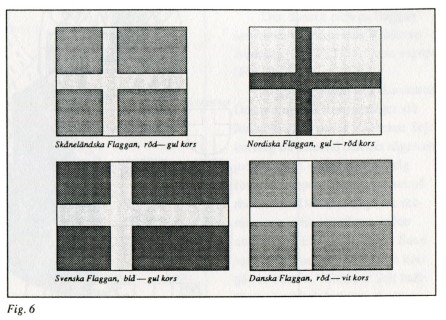
In several places in the Nordic countries, the red and yellow cross coat of arms occurs in connection with churches. This is logical, if it was issued by Lund and all bishops were under the jurisdiction of the Archbishop of Lund, as their primate.
Norge och Finland
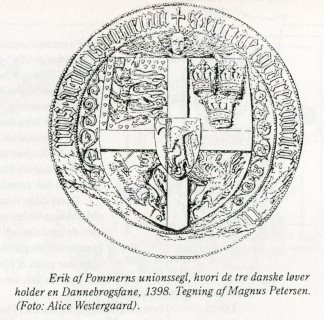
When the common Nordic church organisation finally split into various state churches in the 16th century, these coats of arms lost contact with their origin and were dispersed further along separate lines.
In Norway, the red and yellow cross coat of arms exists as a sun cross in the coat of arms of St. Olav, and it is this coat of arms that National Samling (NS) used during the 1930's and 40's. In the University of Oslo's collection of antiquities there is a painting from an unknown church, 1320-1340, in Trondheim, which shows the death of Olav II Haraldsson in the battle of Stikkelstad in 1030. His coat of arms is a red shield with a golden cross.
In Finland, the red and yellow flag is used primarily by Finnish-Swedes and it can perhaps be traced back to the coat of arms of the Diocese of Åbo, which in turn may be derived from the Archdiocese of Uppsala, as previously mentioned. Before the acceptance of the Finnish blue and white flag as a national flag in 1917, the red and yellow cross flag was a strong pretender. This was because the national coat of arms is a yellow lion on a red background, and it would have been natural to have a red and yellow national flag (Klinge, 1988).
The Coat of Arms in Scania

In Scania, the red and yellow cross coat of arms appears in the coat of arms of Sölveborg (Fig. 7) from 1535: A red cross surrounded by four s-shaped figures on a silver field. In the modern coat of arms, these figures have become eels. Another interesting city coat of arms, from the point of view of flags, is that of Trelleborg from 1421 and 1556 (Fig. 8). The field is blue and the castle and waves are silver, the moon and stars are gold and the flags are Dannebrog flags - red with a silver cross.
It has also been suggested by Hans Sivörn, Växsjö, in a letter to the editor of Arbetet in 1967, that the red and yellow cross coat of arms used to be that of Värend. It may have been carried by Nils Dacke in his fight against the Swedish Centralist State.
These facts point to the possibility that the red and yellow cross coat of arms very well may have been the coat of arms of the Nordic and Scanian Archbishops of Lund. It was later given to the Diocese of Nidaros in Trondheim and the Diocese of Uppsala, as well as being the basis for the coat of arms of the Nordic Union as a worldly power.
Flag Symbolism in Scandinavia
In this section, two legends have been referred to: The legend of the Dannebrog and the legend of Erik. In this context, it must be emphasised that a legend is a literary method or source of knowledge, not a historically descriptive one. It is more like a sermon, based on ideals that are admired in the subject of the legend. As points of reference, legends are not very historically and biographically believable, much the same as with biblical stories.
In the legends mentioned, flag signs in the sky occurred, and this should be interpreted as an idiomatic expression, a metaphor, modelled on biblical apocalyptic literature and the interpretation of this literature by medieval painters and artists. The expression is used todescribe victory and whose victory we are dealing with. In other words, it is imagery for an existential question.

This symbolism is found as victory flags in Christianity, the victory of Christ over death, e.g. in the pulpit of Stora Köpinge church and the altarpiece of the church in Perstorp. Also the coat of arms of Gotland and the Diocese of Visby are included in this symbolism (Fig. 5), Agnus Dei, God's lamb, with the flag as a sign of victory. God's lamb is Christ, who is sacrificed but who is victorious with flag raised high at the resurrection and the Ascension. (Fig. 9)
